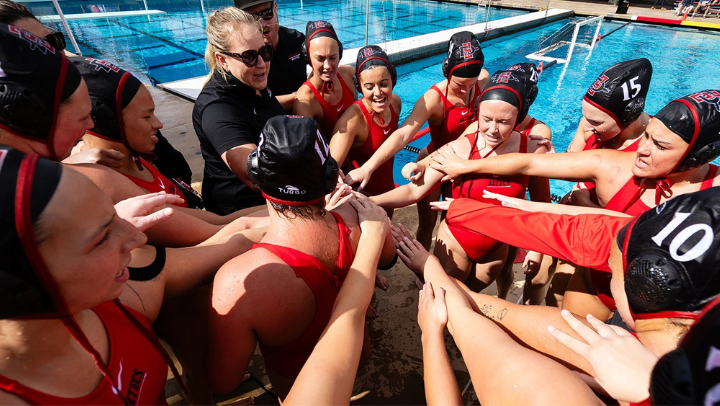Evolving the Blue Economy
SDSU biologists are leading a nationwide team to revolutionize kelp farming.

What if verdant, sustainable farms could produce alternative fuel sources and nutritious food for indigenous cultural uses and international markets while simultaneously helping slow climate change?
That’s the untapped potential for aquaculture along the coast of the western United States, and San Diego State University researchers are overcoming the obstacles — both regulatory and scientific — to make it a reality.
SDSU biologist Matthew Edwards and postdoctoral researcher and microbial ecologist Laís Lima (Ph.D., ‘21) are leading a team of nonprofits, government agencies, tribal partners and labs across the country to identify and solve problems that are keeping Pacific Ocean kelp farming dead in the water.
Why Kelp?
Seaweeds, the category to which 30 types of kelp belong, account for 27% of global marine agriculture production. The multiple uses of seaweed — in food, carbon sequestering, ceremonial art and alternative energy, to name a few — are estimated to comprise a $16.7 billion industry worldwide. But over 97% of seaweed is produced in Asia, with the U.S. contributing less than 1% to international markets.
The slow growth of the industry on the West Coast is partly attributable to the decimation of over 95% of California kelp forests due to warming waters and an explosion of sea urchin populations. Also to blame is a confusing web of local, state and federal rules for securing permission to start kelp farms.
The first North American kelp farm was permitted in 2010. In the 12 years since, around 100 farms have been permitted in the eastern U.S., where sugar kelp is extensively farmed. On the western coast, however, just 20 farms started in Alaska, where kelp is an important part of tribal culture. And on the 7,863-mile stretch of coast from California to Washington, fewer than 10 seaweed farms have been permitted.
Pain Points
SDSU master’s student Leslie Booher and her partner Torre Polizzi faced the hurdles of permitting and trying to adapt East Coast growing advice when starting their kelp farming company, Sunken Seaweed.
The couple first teamed up with Edwards to study how Ulva lactuca, or sea lettuce, could be used to capture toxins in the San Diego Bay. But they had bigger dreams for the scale of kelp farming.
When the National Science Foundation put out a call for what Lima described as “a moonshot idea: something very collaborative, very applied and out there” to reinvent the so-called blue economy, or aquatic agriculture, the four kelp enthusiasts put their hat in the ring.
“It feels like we’re living in a historical moment because this industry has so much potential to be renewable, sustainable and bring a lot of value to people,” Booher said.
After receiving an initial round of funding in the fall of 2021, Booher and Polizzi spearheaded interviews with eager farmers and participated in tribal councils in partnership with the Native Conservancy. Interviewees echoed the couple’s own experience: navigating the hoops of the regulations and permits was a discouraging, time-consuming and expensive process.
In addition to the challenges of getting started, farmers also face other barriers to success, including an inconsistent demand from buyers, the prevalence of pests, and kelp mysteriously not growing as well as expected.
To alleviate these woes, the team is working with Greenwave, an ocean farming nonprofit, to develop a free online hub for future kelp farmers. The hub will provide streamlined permitting software, a network of customers and a best practices manual informed by Lima and Edwards’s research.
“In science, usually the approach is to investigate interesting questions,” Lima said. “With this project, everything we think about and design has to help people, a sector, a community.”
Mysterious Microbes
Answering the unknowns of what helps kelp grow best will require taking a page out of the terrestrial farm playbook.
“In land agriculture, the microbiome is already recognized as important for cycling nutrients and photosynthesis,” said Lima. “Corn and soy have been optimized with their microbiome communities.”
Yet which microbes are beneficial partners to boost crop productivity is much less understood in the ocean.
Applying their expertise in metagenomics and ecology, the researchers are analyzing which microscopic organisms cohabitate with healthy kelp and what roles they play in kelp growth.
In one of the biggest and most spatially distributed kelp sampling projects ever, the SDSU team and their partners used custom-made syringes called super suckers to collect both the seawater environment and seaweed tissue from over 125 samples from seven species across seven existing farms from San Diego to Alaska.
Lima’s preliminary analysis of these samples revealed 30 types of bacteria and viruses that could benefit kelp growth.
Giant kelp samples from farms had similar bacterial communities — which prevent undesirable biofouling organisms from growing on the kelp blades — to a natural kelp bed nearby, suggesting that these farms likely have no negative impacts on the ocean ecosystem. Additionally, different kelp species relied on a variety of microbial partners for cycling nitrogen, which is essential for kelp growth and often more limited in warming waters.
In the next phase of the project, SDSU researchers and their collaborators will conduct experiments and further analyze microbial genomes to verify which combinations of bacterial communities, temperature, flow rate and depth of farm will be most productive. Developing probiotics to enhance different physical characteristics of kelp – such as desired taste, crunchy texture, larger blades, or adaptations to higher temperatures – is on the horizon.
“It’s very exciting to be in this position where science meets business,” Edwards said.



